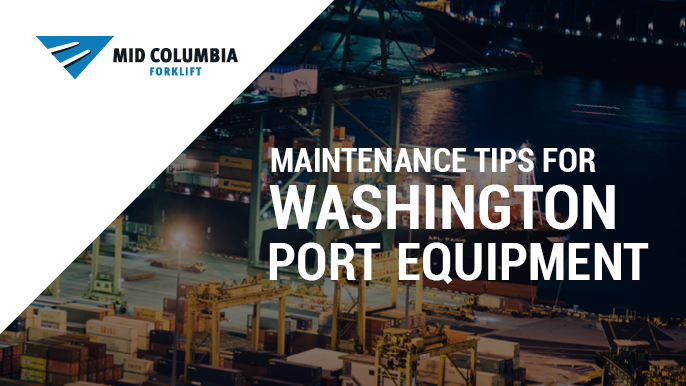Maintenance Tips for Washington Port Equipment
by Phil Hanford, on January 7, 2020 at 6:56 AM

For material handling businesses operating in Washington ports, maintaining equipment is a top priority. It can also be one of the biggest challenges. Due to environmental factors, the wear and tear on equipment due to heavy lifting, and similar challenges, keeping port equipment running in top condition can be extremely difficult. It doesn’t have to be, however.
Apply these top maintenance tips from the material handling pros at Mid-Columbia Forklift and MidCo Material Handling to help keep your port equipment fleet operating at top capacity.
Preventive Maintenance for Port Equipment
An aggressive preventive maintenance plan is key for maintaining any fleet of material handling equipment. Staying on top of regular maintenance and part repair is essential for keeping the large and expensive pieces of equipment functioning. Regularly checking, topping off, and replacing hydraulic fluid, oil, tires, and other key components is essential for keeping heavy-duty equipment functioning properly. Equipment downtime means containers don’t reach their destinations on time, which can be disastrous for your business as well as your customers’. Consider outsourcing your planned maintenance to a trusted partner to save time and improve equipment performance.
Oil and Filter Maintenance for Port Equipment
For port equipment, oil and filter maintenance are key. The extra salt content and moisture in the air can gum up filters at a much more rapid pace than in other industries. That gunk can extend to cause impurities in your oil that can cause serious issues with your engine. Increasing the frequency of your oil filter replacements and regularly checking and topping off oil can help offset the unique challenges created by port environments.
Daily Inspections for Port Equipment
In addition to regularly scheduled inspections, operators should conduct daily walk-around inspections of port equipment prior to beginning their shifts. This gives a great opportunity to spot problems such as corrosion, possible leaks, dents, exposed wires, and other issues in a visual check. Operators and maintenance workers should also grease high-use parts daily to offset excessive wear and tear in equipment.
Combating Corrosion in Port Equipment
Salty sea air and ocean spray present a unique challenge to port equipment operations. The sodium content can contribute to rapid rusting and other corrosion on body plates and key equipment components. Regular greasing can help offset this to keep high-use parts insulated from the ocean air. Many equipment manufacturers offer equipment packages with corrosion-resistant paint, sealed wiring, and other design considerations to offset the risk presented by these environmental factors.
Is maintaining your port equipment a stumbling block for your operation? Contact us to see how the experts at Mid-Columbia Forklift and MidCo Material Handling can help. Our team of dedicated experts is ready to help you find the right solution to your equipment maintenance challenges.
Further Reading:
Why You Should Outsource Your Forklift Planned Maintenance
Equipment Challenges for Washington’s Forest Products Industry
4 Key Material Handling Configurations for Washington Port Efficiency




